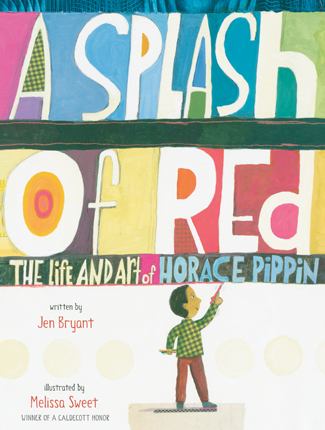Full Text Reviews: Booklist - 11/01/2012 *Starred Review* Born in Pennsylvania in 1888, Horace Pippin loved to draw and paint as a child. When he was in eighth grade, his father left the family. Horace quit school and worked to support them. Later wounded as a soldier in WWI, he never regained full use of his right arm. Back home, Pippin began painting again, using his left arm to guide his right. Painting subjects drawn mainly from observation, memory, family stories, and the Bible, this self-taught African American artist was eventually discovered by the art community. Major museums display his works, and their locations are indicated on the U.S. map on the back endpapers, along with small reproductions of six paintings. In a well-structured narrative with recurring themes and a highly accessible style, Bryant writes short sentences full of memorable details, from Pippin’s first box of colored pencils to the scavenged house paints he used to paint his wartime memories. Combining drawings and printed elements with watercolor and gouache paints, Sweet’s mixed-media illustrations have a refreshing, down-home style and a brilliance all their own. The artwork incorporates large-print quotes, giving Pippin a voice here as well. Outstanding. - Copyright 2012 Booklist. Bulletin for the Center... - 01/01/2013 Though artistically inclined since childhood, African-American artist Horace Pippin had to limit his drawing and painting to a hobby, and then even that pleasure was denied him when he suffered an injury to his right arm in World War I. Back home and struggling with the limited opportunities for a man with a physical impairment, Pippin turned again to art, steadying his damaged right arm with his left. When his paintings were discovered by a local group of artists (including N. C. Wyeth), they gained recognition and acclaim in the art world and cemented Pippin’s reputation. Both Pippin’s life and art are compelling, and Bryant’s matter-of-fact, unassuming style is well suited to her subject. Sweet’s art, largely watercolor and gouache with layered collage effects, employs vibrant contrasts of reds and pinks against greens, with softly sketchy pencilwork adding both texture and precision. Pippin himself was very much a vernacular artist, and the narrative paintings effectively reflect his approach (though it would have been pleasing to have more examples of Pippin’s own work); quotes from Pippin are graphically incorporated into several scenes. The book concludes with an historical note about Pippin, a note from the author and the illustrator on their joint exploration of the subject, an extensive list of print, video, and internet opportunities for further information about the artist, and citations; closing endpapers offer a U.S. map identifying the location of museums housing Pippin’s works and some sample paintings. This would be a great creative partner to Lyons’ Starting Home: The Story of Horace Pippin, Painter or an entry in a discussion of American modern art. DS - Copyright 2013 The Board of Trustees of the University of Illinois. School Library Journal - 01/01/2013 Gr 3–6—Born in 1888, grandson of a slave, Pippin loved to draw from an early age. He painted "…every day scenes in natural colors; then he added a splash of red." His classmates often begged, "Make a picture for us, Horace!" When he was in the eighth grade, he quit school and went to work. From rail yard to farm to hotel to factory, his workmates echoed the request, "Make a picture for us…." And when he enlisted in World War I, his fellow soldiers also entreated him to draw. "The war brought out all the art in me." But a bullet to the shoulder rendered his right arm useless and he was unable to find work due to his injury. Still, his drive to draw remained. One day, "using his good arm to move the hurt one, he scorched lines into the wood" to create a picture. With practice, his weak arm improved enough to allow him to paint, and paint he did. N.C. Wyeth recognized his talent and arranged for him to have a one-man exhibit. Today his work hangs in museums all over the country. Bryant's meticulously researched, eloquent text makes this a winning read-aloud, while Sweet's vibrant, folksy illustrations, rendered in watercolor, gouache, and mixed media, portray the joys and hardships of the man's life, using his trademark palette…with just a splash of red. Quotations from his notebooks, letters, and interviews are effectively woven into the pictures.—Barbara Auerbach, PS 217, Brooklyn, NY - Copyright 2013 Publishers Weekly, Library Journal and/or School Library Journal used with permission. Loading...
|



